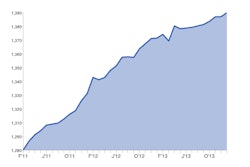A “Myth-busters” session on recruitment and retention at the annual TCA conference ongoing in Nashville, Tenn., revealed emerging best practices for making the application process easier for both drivers and the recruiters called on to manage an increasingly digital application process.
Among the presenters was Dave Chesterman, recruiting director for Celadon, who has worked with ACS in recent times to develop a “virtual recruiter,” a landing page to which drivers are led by pay-per-click advertising in major search engines. The page includes a form that gathers just enough information from the driver in order to determine whether he or she is “pre-qualified.”
 “A lead is an introduction,” says Nick Reid, Randall-Reilly vice president of digital services. “As users get more impatient, there’s that browser mentality” of being “information rich and time poor. They’ll trade information, but not time.” Successful recruiting departments will ask themselves: “What can I do that doesn’t make someone commit a whole lot of their time just to apply?”
“A lead is an introduction,” says Nick Reid, Randall-Reilly vice president of digital services. “As users get more impatient, there’s that browser mentality” of being “information rich and time poor. They’ll trade information, but not time.” Successful recruiting departments will ask themselves: “What can I do that doesn’t make someone commit a whole lot of their time just to apply?”When a driver submits his/her form, they are near-instantaneously notified if they are pre-qualified — a Celadon recruiter likewise receives a call from the automated system to connect via telephone to that driver at once, if desired.
Such “virtual recruiters” have allowed the company to build solid leads, Chesterman said. In the “very short time” the system has been in place, “we’ve hired over 40” drivers, he says — the call system will cost the company just $1,000 monthly, with pay-per-click costs adding to that total, depending on volume, to represent hard costs of the system.
He and others presenting in the session see such systems as effective ways to better funnel what otherwise may be an unmanageable pool of digital leads for recruiters.
Nick Reid, digital services vice president with CCJ publisher Randall-Reilly, similarly stressed methods for generating quality leads in greater volumes. With well more than 50 percent of today’s drivers using the Internet via a mobile device of one kind or other, he said, “making it as easy to apply in whatever way [drivers] want to” is much more important.
Recruiters can learn lessons from publishers on making their first contacts with prospective recruits as interesting as possible in order to capture their attention and build meaningful connection. “Don’t try to go beyond interest all the way to closing” on a single page, he said, offering examples of unnecessarily-detailed forms and non-mobile-friendly sites that make the process mechanically difficult.
As was the case in Chesterman’s example, Reid said, creating interest is “about standing out.”
A near-immediate response from the carrier in Chesterman’s case showed the pre-qualified driver that this is a company that is serious about his potential as a recruit.
Reid gave the example of a landing page for a small Florida fleet whose most attractive attribute was that all of its drivers were home every weekend, no exceptions. In building a recruiting landing page, Reid and his team focused on that for all copy and images. Splashed in bold type over a pleasing truck image and next to a very simple form optimized for mobile was the phrase: “We get Florida drivers home weekly.”
“Play to the strength of your offer,” he said, and where possible, make the message personal, as in this one directed right at Florida drivers.












